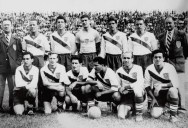This Day In History – June 29th

ST-HILAIRE TRAIN DISASTER – JUNE 29, 1864

The St-Hilaire train disaster was a railroad disaster that occurred on June 29, 1864 near the present day town of Mont-Saint-Hilaire, Quebec. A Grand Trunk train carrying between 354 and 475 passengers, many of them German and Polish immigrants, were travelling from Quebec City to Montreal.
At around 1:20 a.m. local time the train was approaching a swing bridge known as the Belœil Bridge on the River Richelieu. The swing bridge had been opened to allow the passage of five barges and a steamer ship. A red light a mile ahead of the bridge signalled to the train that the crossing was open and it needed to slow. However the light was not acknowledged by the conductor, Thomas Finn, or the engineer, William Burnie, and the train continued towards the bridge.
At 1:20 a.m. the train came onto the bridge and fell through an open gap. The engine and eleven coaches fell through the gap one after another on top of each other crushing a passing barge. The train sank into an area of the river with a depth of 10 feet. 99 people aboard the train were killed and 100 more were injured. Among the dead was Thomas Finn and the fireman aboard the train. The engineer was hurt slightly in the accident but was able to escape the wreck. The disaster was blamed on the conductor and engineer for failing to obey the standing order to stop before crossing the bridge. The engineer, who had only been hired recently, claimed that he was not familiar with the route and that he did not see the signal.
The disaster remains the worst railway accident of Canadian history. [Source: Wikipedia]
‘MIRACLE ON GRASS’ US VS ENGLAND WORLD CUP – JUNE 29, 1950

Photograph via Who Ate All the Pigs
At the time, the English considered themselves the “Kings of Football”, with a post-war record of 23 wins, 4 losses, and 3 draws. Conversely, the Americans had lost their last seven international matches (including the 1934 World Cup and 1948 Summer Olympics) by the combined score of 45–2. The odds were 3–1 the English would win the Cup, and 500–1 for the U.S.
The American team consisted of semi-professional players, most of whom had other jobs to support their families. Walter Bahr was a high school teacher, Frank Borghi drove a hearse for his uncle’s funeral parlor, and others worked as mail carriers or dishwashers. The team had also been hastily assembled, and had only been able to train together once, and that was the day before they left for Brazil, which happened to be against the touring English team featuring Matthews. “We have no chance,” recently-appointed coach Bill Jeffrey told the press.
In the thirty-seventh minute, Bahr took a long shot twenty-five yards out, but as Williams moved to his right to intercept, Gaetjens dived headlong and grazed the ball enough to put it to the left of the English goalkeeper, whose momentum prevented him from changing direction, and into the back of the net. The crowd exploded as the U.S. improbably led and eventually won, 1–0.
England lost their next match and failed to qualify for the Final Round, finishing the First Round with a record of 1–0–2.
The U.S. lost their next match 5–2, versus Chile, ending their 1950 World Cup run with a First Round record of 1–0–2. They would not qualify for the World Cup again until 1990. [Source: Wikipedia]

Photograph via SportingIntelligence
1ST FEMALE HEAD OF STATE IN WESTERN HEMISPHERE – JUNE 29, 1974

Isabel Perón, is a former President of Argentina. She was also the third wife of another former President, Juan Perón. During her husband’s third term as president, Isabel served as vice president and following her husband’s death in office, Isabel served as president. She was the first non-royal female head of state and head of government in the Western Hemisphere.
Juan Perón suffered a series of heart attacks on June 28, 1974. Isabel was summoned home from a European trade mission and secretly sworn in as interim president the next day on June 29th. Juan Perón died on July 1, 1974, less than a year after his third election to the presidency.
Although she seemed to lack Evita’s charisma, the nation at first rallied to the grieving widow in this, her role of a lifetime. Following a string of mysterious murders, public threats from leftist extremists and a wave of industrial strikes in September, 1974, her popularity began to decline. The greatest source of contention between her and the voters was the increasing undeniability that José López Rega, the Minister of Social Welfare, set the agenda over a broad swath of Mrs. Perón’s policies. Vetting nearly all domestic and foreign policy, he became de facto prime minister.
In 2007, an Argentine judge ordered the arrest of Isabel Perón over the forced disappearance of an activist in February 1976, on the grounds that the disappearance was authorized by her signing of decrees allowing Argentina’s armed forces to take action against “subversives”. She was arrested near her home in Spain on 12 January 2007. Spanish courts subsequently rejected her extradition to Argentina. [Source: Wikipedia]

MIKHAIL BARYSHNIKOV DEFECTS TO CANADA – JUNE 29, 1974

Photograph by Annie Leibovitz
Mikhail Nikolaevich Baryshnikov (born January 27, 1948) is a Soviet-born Russian American dancer, choreographer, and actor, often cited alongside Vaslav Nijinsky and Rudolf Nureyev as one of the greatest ballet dancers of the 20th century. After a promising start in the Kirov Ballet in Leningrad, he defected to Canada in 1974 for more opportunities in western dance. After freelancing with many companies, he joined the New York City Ballet as a principal dancer to learn George Balanchine’s style of movement. He then moved to New York to dance with the American Ballet Theatre, where he later became artistic director.
Baryshnikov has spearheaded many of his own artistic projects and has been associated in particular with promoting modern dance, premiering dozens of new works, including many of his own. His success as a dramatic actor on stage, cinema and television has helped him become probably the most widely recognized contemporary ballet dancer. In 1977, he received a nomination for the Academy Award for Best Supporting Actor and a Golden Globe nomination for his work as “Yuri Kopeikine” in the film The Turning Point.
On June 29, 1974, while on tour in Canada with the Bolshoi Ballet, Baryshnikov defected, requesting political asylum in Toronto, and joined the Royal Winnipeg Ballet. He also announced to the dance world he would not go back to the U.S.S.R. He later stated that Christina Berlin, an American friend of his, helped engineer his defection during his 1970 tour of London. His first televised performance after coming out of temporary seclusion in Canada was with the National Ballet of Canada in La Sylphide. He then went on to the United States. [Source: Wikipedia]

Photograph by Annie Leibovitz
THE SAMPOONG DEPARTMENT STORE COLLAPSE – JUNE 29, 1995

The Sampoong Department Store collapse was a structural failure that occurred on June 29, 1995 in the Seocho-gu district of Seoul, South Korea. The collapse is the largest peacetime disaster in South Korean history – 501 people died and 937 were injured.
The Sampoong Group began construction of the Sampoong Department Store in 1987 over a tract of land previously used as a landfill. Originally designed as an office building with four floors, it was changed to a large department store during its construction by Lee Joon, the future chairman of the building. This involved cutting away a number of support columns in order to install escalators. When the original contractors refused to carry out these changes, Lee ignored and fired them and hired his own building company for the construction.
The building was completed in late 1989, and the Sampoong Department Store opened to the public on July 7, 1990, attracting an estimated 40,000 people per day during the building’s five years of existence.
Later on, a fifth floor was added, which was first planned to be a skating rink to comply with zoning regulations that prevented the whole building from being used as a department store. Lee changed the original plan for the fifth floor to include eight restaurants instead. When a construction company tasked to complete the extension advised that the structure would not support another floor, they were fired, and another company finished the job.
The restaurant floor also had a heated concrete base with hot water pipes going through it, as patrons sit on the floor of traditional Korean restaurants, which added a large extra load due to the increase in thickness of the concrete slab. In addition, the building’s air conditioning unit was installed on the roof, creating a load of four times the design limit.
Lee Joon was charged with criminal negligence and received a prison sentence of 10.5 years. However, Joon’s sentence was reduced to seven years on appeal in April 1996. Joon died of health complications on October 4, 2003, a few days after being discharged, relating to heart failure, high blood pressure and diabetes. [Source: Wikipedia]
1ST US SHUTTLE DOCKING TO MIR SPACE STATION – JUNE 29, 1995

Photograph by NASA
STS-71 was the third mission of the US/Russian Shuttle-Mir Program, which carried out the first Space Shuttle docking to Mir, a Russian space station on June 29, 1995. The mission used Space Shuttle Atlantis, which lifted off from launch pad 39A on 27 June 1995 from Kennedy Space Center, Florida. The mission delivered a relief crew of two cosmonauts, Anatoly Solovyev and Nikolai Budarin, to the station, along with recovering American Increment astronaut Norman Thagard, and was the first in a series of seven straight missions to the station flown by Atlantis.
The five-day docking marked the creation of the largest spacecraft ever placed into orbit at that time in history, the first ever on-orbit changeout of Shuttle crew members, and the 100th manned space launch by the United States. During the docked operations, the crews of the shuttle & station carried out various on-orbit joint US/Russian life sciences investigations aboard Spacelab/Mir and a logistical resupply of the Mir, along with the Shuttle Amateur Radio Experiment-II (SAREX-II) experiment.
Docking occurred at 9 am EDT, 29 June, using R-Bar or Earth radius vector approach, with Atlantis closing in on Mir from directly below. When linked, Atlantis and Mir formed the largest spacecraft ever in orbit, with a total mass of about 225 metric tons (almost one-half million pounds), orbiting some 218 nautical miles (404 kilometres (251 mi)) above the Earth.
The returning crew of eight equaled the largest crew (STS-61-A, October 1985) in Shuttle history. To ease their re-entry into gravity environment after more than 100 days in space, Mir 18 crew members Thagard, Dezhurov and Strekalov lay supine in custom-made recumbent seats installed prior to landing in the orbiter middeck. [Source: Wikipedia]

Photograph by NASA
CLICK HERE TO SEE ALL PREVIOUS ‘THIS DAY IN HISTORY’ POSTS
Trending on TwistedSifter




